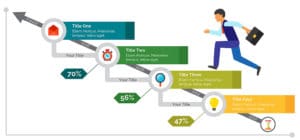Same markets, same statistics, two sets of propositions. Make your mind !
Is the ‘Trump effect’ real ? The question looks a bit incongruous so the economic indicators and the financial markets have been prone to a strong up move since the election day.
Let us reformulate then: what is the real effect of the US election on the economy ? Is it robust or temporary? Was it already the case prior to the election ? Should one differentiate expectations and real conditions? In a nutshell: should we trust the recent impetus of confidence or not ?
In his latest post ‘The Recession is over’, Ed Yardeni, President and Strategist in Chief of Yardeni Research, seems to give a clear answer: yes.
His views marry the conventional ‘reflationary trade’ rationale, but in a differentiated way that attracted our attention: the Trump effect plays a key role on perception, but less so on some key fundamental variables.
Two economic engines are actually identified. They were already supporting the global economy beforehand:
(emphasis ours)
“Despite the media’s 24/7 focus on everything Trump, there may be a couple of other reasons why the global economy is showing signs of better growth:
|
So much for the underlying economic engines.
What about climax, business sentiment and economic expectations ? Yardeni rightly reconnects to the Trump effect :
“There is only one obvious explanation for the remarkable vertical ascent in the Small Business Optimism Index over the past three months through January: Donald J. Trump. The index, which is compiled by the National Federation of Independent Business (NFIB), jumped from 94.9 during October to 105.9 during January, the highest since December 2004. That 11.0point increase is reminiscent of a comparable leap higher during 1980 when business owners started to anticipate that Ronald Reagan might beat Jimmy Carter in that year’s November presidential election. There was another similar outsized increase during 1982 and 1983 when Fed Chairman Paul Volcker lowered interest rates to revive the economy from a severe recession.” |
This obviously doesn’t mean that expectations will meet reality, in particular if the above economic engines, as we believe, will fail to ignite.
Likewise, inflation expectations do not necessarily reflect current inflationary pressures:
“So far, there isn’t much evidence that wage inflation is picking up in the average hourly earnings data that are released by the Bureau of Labor Statistics in the monthly employment report. Previously, I have shown that there is more wage pressure showing up in the Atlanta Fed’s Median Wage Tracker. In any event, so far over the past six months on average, only 3.3% of small business owners said they were actually raising their selling prices.” |
It becomes apparent that the vertical ascent of business expectations is based on fiscal policy guidance. Are they realistic?
Yardeni takes a closer look at employment, GDP, wages, tax revenues and business activity promises. About employment :
“Is promising to create 25 million jobs an unrealistic whopper by a fellow who tends to tell whoppers? Or is President Donald Trump simply thinking big, as he is wont to do? In a 9/15 campaign speech at the New York Economic Club, he predicted that his plan would increase employment by 25 million new jobs over the next 10 years. I looked at the 10year change in payroll employment since the start of the data during 1939. The most this series has ever increased was 24.2 million jobs from May 1991 through May 2001. That period spanned the presidencies of George H. Bush and Bill Clinton. Looking at the eightyear changes, the biggest increase for any twoterm president was 23.5 million under Bill Clinton. So the economy has added nearly 25 million jobs before, but it may be harder to do so again over the next 10 years. |
As Yardeni points out, markets are cheering very supportive earnings’ expectations. An optimism that is another consequence of the ‘Trump effect’, more precisely an irresistible shift of attention towards fiscal policy :
“For a change, let’s ignore Washington. Let’s ignore the Republicans and the Democrats. Let’s ignore the White House, Congress, and K Street. That’s what the financial markets were doing for the past eight years. Investors were focusing most of the time on the Fed and the other central banks. Now we are all being forced to participate (in one way or the other, though mostly as observers) in the greatest circus of all times. I guess that is only fitting now that Ringling Brothers is going out of business. Instead it will be Cirque du Trump 24×7 for the next four years.” |
Really? Creative forward guidance tools proved to be very expensive in the monetary regime. Will the ‘Cirque du Trump’, as Yardeni amusingly names it, be that different?
Isn’t it dangerous to build an economic and market scenario on optimism as a self-sufficient driving force ?
Yardeni concludes with these impressive and market impacting numbers, leaving the previous question unanswered.
“The consensus estimate for 2018 has been moving higher in recent weeks, which doesn’t usually happen, as optimistically biased analysts typically lower their distant forecasts as reality approaches. Analysts may be starting to incorporate tax cuts and less regulation into their 2018 estimates. They now expect that 2018 earnings will rise 12.0%, following this year’s gain of 12.3%.” |
As long as it lasts …
To sum up :
- Ed Yardeni makes a very valid point by distinguishing relevant underlying economic variables (oil, China) and climax ones (business sentiment, leading indicators, expectations)
- While the first ones were already in force prior to the election, the second ones reacted sharply to the Trump effect
- Assuming the energy recession is over – almost an alternative title for his post – and a successful management of the Chinese credit landing, Yardeni sets the stage for a virtuous fiscal guidance circle …
- … that translates into impressive earnings’ expectations and market momentum.
We suggest :
- Yardeni’s scenario is fully depending on public policies: OPEC for oil prices, Chinese authorities for credit and capital controls, the US administration for fiscal reflation, central banks for non-disruptive legacy and exit strategy
- We agree with this: the current macro-financial environment is in a ‘peak public situation’. More policy control would hardly be thinkable, unless maybe considering a global sovereign fund.
- We side with Yardeni on oil and China : the trends were already in force prior to the US election. Their development will likely dominate the fate of fiscal policy.
- But we (almost completely) disagree with his underlying assumptions:
> The oil recession is not over: this a fragile late cycle rebound of a much longer and sticky downward process
> The credit landing in China will continue, most probably – and hopefully – towards a soft landing
> China, oil prices and global trade should be considered in a broader credit and deleveraging perspective. Credit, we believe, is the real name of the game. - This, in turn, sets the stage for a less virtuous fiscal guidance circle …
- … which may translate into growth and earnings’ disappointments.
With kind regards,
Jacques





